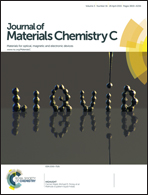Polyoxometalate-based organic–inorganic hybrids for stabilization and optical switching of the liquid crystal blue phase†
Abstract
We develop two novel bent- and dendritic-like polyoxometalate (POM) organic–inorganic hybrids with covalently grafted azobenzene mesogenic moieties for stabilization and optical switching of BPs. The bent-like POM hybrid is found to be greatly effective for the stabilization of BP I, in which the widest BP I temperature ranges could reach 20.5 °C. Moreover, what surprises us is that, the dendritic-like POM hybrid could help to stabilize BP II. The related physical mechanisms of the BP stabilization are discussed on the basis of the elastic characteristics and orientational order of LC molecules. Additionally, the wide optical tuning of the Bragg reflection band of BP II is demonstrated, in which the shift of the Bragg reflection wavelength is around 80 nm. This work opens up a new way for developing the BP systems that exhibit wide temperature ranges and good switching effects by optical fields, leading to potential applications in display fields as well as optoelectronic devices.


 Please wait while we load your content...
Please wait while we load your content...